Loulou de la Falaise: The Glamorous Romantic
by Ariel de Ravenel and Natasha Fraser-Cavassoni (Rizzoli)
Editor: Ariel de Ravenel
Writer: Natasha Fraser-Cavassoni
Art Director: Alexandre Wolkoff
Loulou de la Falaise: The Glamorous Romantic celebrates the creations of Anglo-French jewelry, accessories and clothing designer Loulou de la Falaise. Published in October, 2014, the book is insightfully edited by Loulou’s friend and former business partner Ariel de Ravenel. The text is authored by fashion journalist Natasha Fraser-Cavassoni, who along with having interviewed Loulou over the years also mixed in the same international fashion/design/media milieux as her subject.
Masterfully art directed by Alexandre Wolkoff, there are over 400 professional and candid images in this book, which is the first ever to document the evolution of Loulou’s style and prolific output. The bulk of the book’s images covers her glamorous 1960s youth-quaking years in London, Paris and New York. Then there are the many superb images from 1972 – 2002, which span Loulou’s creative and spiritual marathon as Yves Saint Laurent’s jewelry and accessories designer, muse and dear friend.
The book’s crystalline chronicle of Loulou’s inimitable chic, design oeuvre and unforgettable beauty begins with the artfully blurred black and white cover photograph by Michael Roberts. Posing with her right hand lightly resting on the opposite shoulder, Loulou’s skillfully shadowed and mascaraed eyes are closed while she puffs dreamily on a just-lit cigarette.
She is clad in a body-con black turtleneck and adorned with what appears to be a four stranded jade or aventurine necklace, gold rimmed jade or hard stone statement earrings with pendant drops, plus a cuff bracelet, all presumably designed by Loulou for one of Yves Saint Laurent’s haute couture collections. Capturing Loulou’s androgynous chic, this photo embodies her love of bold bijoux. Her style transcends fashion and is therefore timeless: quite a well chosen cover image.
Pierre Bergé’s penetrant and heartfelt introduction illuminates what an enchanting person and gifted designer Loulou was. (Bergé was co-founder of the high fashion house of Yves Saint Laurent (YSL). The two were longtime business partners and former lovers.)
“Above all,” Bergé writes, “I should speak of Loulou the designer. Like her mother before her, fashion was in her blood. She had a sharp and exacting eye. Worn by her, clothing appeared as a second skin. Jewels appeared wondrously from her hands, those of a magician. Loulou’s mysterious character was reflected in her enigmatic, otherworldly hats. She had a passion for life, and when she died, many among us knew we had lost something unique.”
One imagines that Loulou, who left this earth in November 2011 at the age of 63, would delight in the luxe production values of this coffee table-sized book. Thankfully, this book contains an image hoard of jewelry that Loulou designed for Yves Saint Laurent’s haute couture and rive gauche collections. Besides being beautiful, these photos are valuable reference for collectors, students and jewelry lovers. There are many superb photos of Loulou wearing a mix of haute couture and ready-to-wear YSL jewels that she designed. Full page color photos shot in Loulou’s rue des Plantes Paris residence provide excellent documentation of Loulou’s museum-like collection of cuffs, bangles, necklaces, earrings as well as a glimpse of her colorful home.
Because of its wealth of images and lucid text, this book is a must-read for jewelry lovers, designers and fashion students seeking a definitive overview of what Loulou designed for Yves Saint Laurent as well as for her eponymous label during the years 2003 – 2006. We also see images of haute luxe jewels she designed for Oscar de la Renta in 2007. Made of stones such as amethyst, tourmaline, citrine, peridot, etc., this collection was fabricated in India under Loulou’s supervision.
Tall, slender and lyrically beautiful in a Pre-Raphaelite way, Loulou stepped out of a Dante Gabriel Rosetti painting to embody bohemian chic like no one before– or since. The daughter of a French count who was a writer and the high fashion model Maxime de la Falaise, Loulou was also the granddaughter of British society portrait painter Sir Oswald Birley and the Irish beauty Lady Rhoda Birley. Artistic abilities and a flair for fashion colored Loulou’s DNA.
Even as a very young child, Loulou drew dresses with inspired silhouettes. She honed her drawing skills as a young woman in New York when she shared an apartment with Joe Eula, who was then a top fashion illustrator. By age 20, Loulou was renowned among international fashion tribes for her fantastically vibrant color sense, exotic combinations of ethnic and vintage jewelry; harmonious high/low accessorizing and talent for tying terrific turbans.
It may seem like a no-brainer today, but Loulou was one of the first 1960s models and stylists to accessorize upmarket designer clothing with such exotic artifacts as Moroccan Berber coral necklaces, turbans and Afghan sterling cuffs inlaid with russet carnelian stones.
Loulou’s approach to ornamentation bubbled with avant-garde vivacity, a respect for traditional cultures, an infectious sense of adventure and alpha female energy. As the book’s images and text make clear, Loulou collected, designed and wore jewelry that pioneered an international, sophisticated and utterly bold style.
Late 1960s portraits of Loulou (who had already forged a reputation for fierce and eccentric chic as a fashion assistant at the British fashion magazine Harper’s Queen), show her swathed in turbans expertly tied Southern Morocco style, while wearing psychedelic Ossie Clark outfits, Saint Laurent boots and an exotic array of jewelry from different eras and ethnic groups.
To see the black and white photos from a 1969 French VOGUE shoot (which the book’s editor Ariel de Ravenel styled, and where she and Loulou began their lifelong friendship) is to appreciate Loulou’s innately romantic and adventurous originality.
To read about Loulou’s prodigious partying habits in the late 1960s and 1970’s, plus her penchant for dancing on tabletops (!) is to enjoy a contact high. To note how one friend after another testifies to Loulou’s gift for friendship, and for living, is to realize how very much they miss her warmth, humor and style. Throughout the book, Pierre Bergé and Saint Laurent’s dear friend and other muse Betty Catroux relate anecdotes about Loulou that are by turns warm, hilarious, touching, and elegiac. (Happily, Saint Laurent’s two muses maintained their cherished friendship until the end of Loulou’s life.)
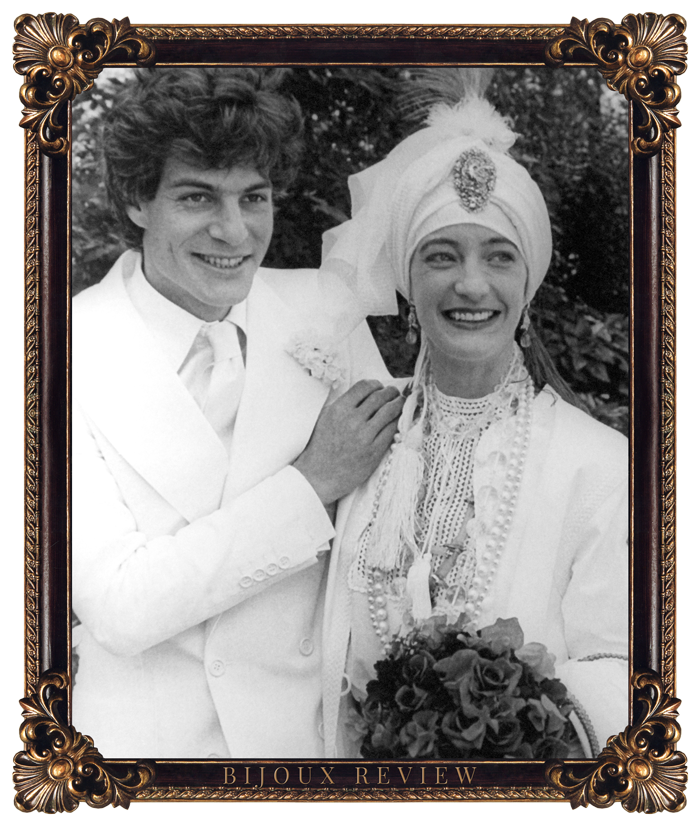
Loulou and her husband, the writer Thadée Klossowski de Rola, on their wedding day, June 11, 1977. Photo by Guy Marineau, from Loulou de la Falaise: The Glamorous Romantic (Rizzoli) Frame courtesy of EKDuncan.
Loulou’s eccentric but refined, trans-global chic is most apparent in photos documenting gala occasions, such as her 1977 wedding to the writer Thadée Klossowski de Rola. (Check out the ropes of pearls , beads and rock crystal necklaces Loulou draped over her white maharajah-style wedding outfit! I think she wore five necklaces.) Loulou completed this androgynously chic look with a white turban from which hung a white and red tassel on either side of her neck.
Secured by a gem-studded brooch and baroque pearl stick pin, Loulou’s wedding turban was topped off by a white and red aigrette. The result: a bridal costume of great originality, whimsy, refinement and chic sophistication. (Loulou’s wedding bouquet consisted of red roses, a stylishly iconoclastic touch, but then again, she did adore RED.) The photos of Loulou and Thadée (attired in a double-breasted white suit and white tie) on their June wedding day prominently feature Yves Saint Laurent and Pierre Bergé, all wreathed in joyous smiles.
One of the finest points of this book is its documentation of the jewelry and other accessories that Loulou created for Yves Saint Laurent between 1972 and 2002. Loulou designed over 2,000 pieces of superb (and today, highly collectable) jewelry a year for Saint Laurent’s haute couture, Rive Gauche and other ready-to wear divisions. That Loulou also designed hundreds of hats, gloves, bags, knitwear pieces and bathing suits that unfailingly made women look beautiful suggests that she was Saint Laurent’s equal in terms of original vision, creative willpower and ability to create irresistible, high luxury goods, as well as more accessibly priced ones.
The book quotes Yves Saint Laurent throughout. His brief character sketch of Loulou suggests why her designs were so vibrant, and why the two of them had such a symbiotic working relationship and profound mutual affection:
“Loulou de la Falaise, known as Loulou…She is composed of brilliant and multicolored facets. Androgynous nymph, she stamps everything she does with a caprice of clashing contrasts, which she alone can harmonize. Her elegance is transfigured by exuberance and revelry.”
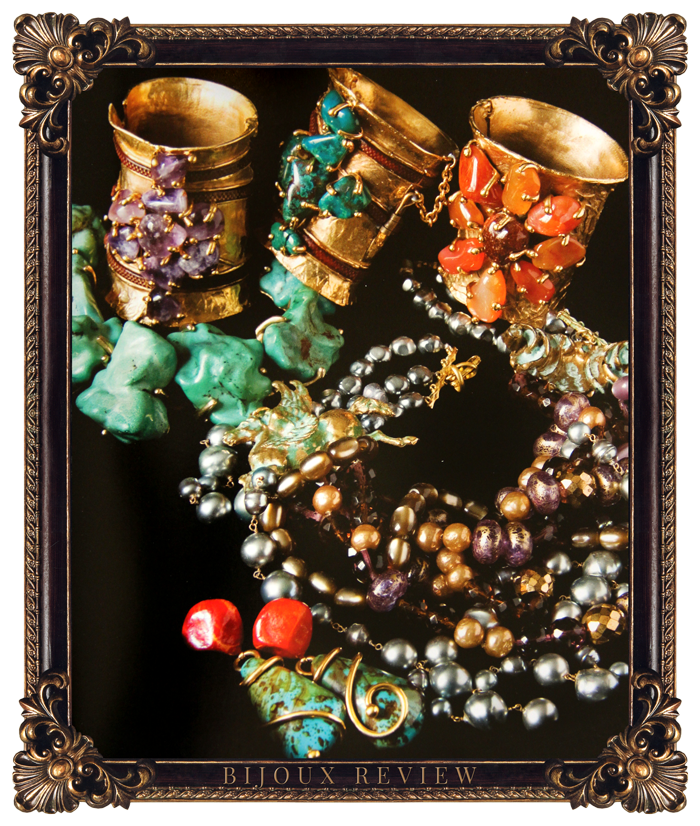
A luxurious array of jewels Loulou designed for various YSL haute couture collections. Photo by Nicolas Matheus from Loulou de la Falaise: The Glamorous Romantic (Rizzoli). Frame courtesy of EKDuncan.
There are also choice quotes in here from Loulou’s colleagues like Anne-Marie Muñoz, who had worked with Saint Laurent at Christian Dior before he and Bergé founded the house of Saint Laurent. Hélène de Ludinghausen, who managed Saint Laurent’s haute couture salon, says of Loulou’s magical personality: “Loulou could charm a wall.”
We also hear from haute luxe shoe designers Manolo Blahnik and Christian Louboutin; Roger Vivier brand ambassador Inès de la Fressange, Loulou’s lifelong friends Marisa Berenson and Diane von Furstenberg, etc.
Exhausted from years of racing to meet fashion’s grueling seasonal deadlines while suffering from bipolar disorder and alcohol abuse, Saint Laurent retired in 2002. A year later, Loulou opened her 7, rue de Bourgogne boutique in the seventh arrondissement on Valentine’s Day, February 14, 2003. The book reprints a colored pencil note of Loulou’s illustrated with a bird perched on a flowering branch singing a springtime song. She writes that her “eternal dream” was to create “an English country house in the heart of beautiful Paris.” Images of this boutique, with billowing multi-colored, semi-sheer flowered curtains and glowing sconces on the walls are gorgeous proof that Loulou fulfilled the dream.
That she opened her boutique on Valentine’s Day further attests to Loulou’s romantic nature. It also suggests why de Ravenel chose to subtitle the book, The Glamorous Romantic. With a pale blue carpet edged in pinkish ruby, angled mirrors that enlarged and brightened the space and hid changing rooms, the boutique brimmed with elegant custom furniture. All of the furniture, including the low, glass-topped cases which displayed jewelry, handbags and scarves, was designed by Loulou and her beloved architect-decorator brother, Alexis de la Falaise.
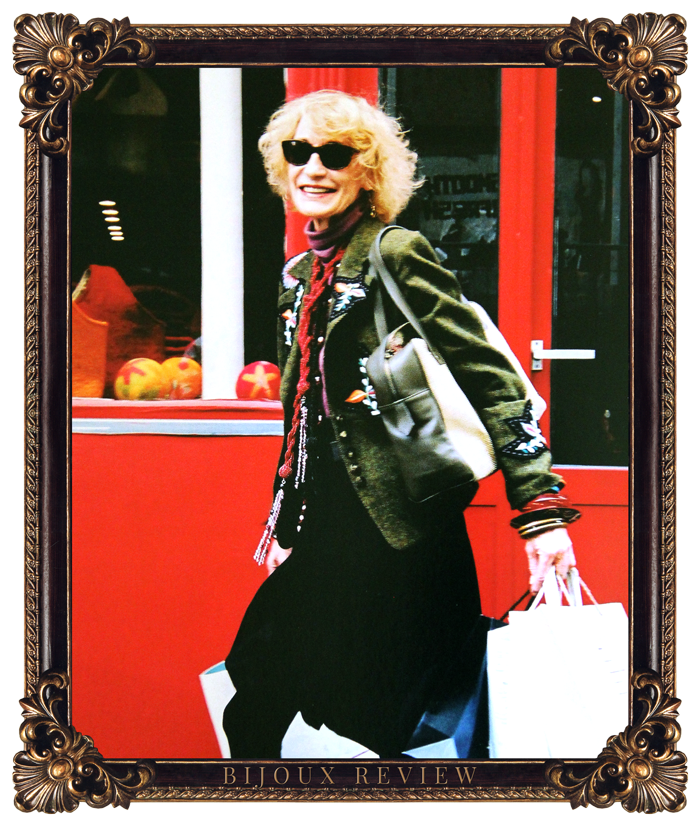
Looking festive, Loulou in a fetish-tweed embroidered jacket designed for her eponymous boutique. Her beaded and tasseled sautoir necklace (also of her own design) is balanced with bold bangles. Photo by Vincent Lappartient from Loulou de la Falaise: The Glamorous Romantic (Rizzoli). Frame courtesy of EKDuncan.
The clothes bloomed in Loulou’s favorite intense colors and parings. Jade silk brocade kimonos with marigold pajama pants; chartreuse silk tops with purple silk trousers; scarlet silk blouses cuffed and collared in lapis blue. On the second floor, flowered curtains fluttered in the breeze and Loulou’s collection of sweaters, linen dresses and classic pantsuits were on offer. Jackets, lined in colorful Liberty of London prints, could be custom ordered.
Color photos by Rose Deren of the jewels Loulou made for her eponymous boutique are enchanting as they are set amidst flowering plants, trees and gardens. All of nature hugely inspired Loulou; she was famous for the lovely gardens she designed around her Boury country house in the Vexin. While New York’s luxury department store Bergdorf Goodman sold her clothes and jewelry and she opened a second boutique on rue Cambon, debts caused Loulou to shutter the business in 2006.
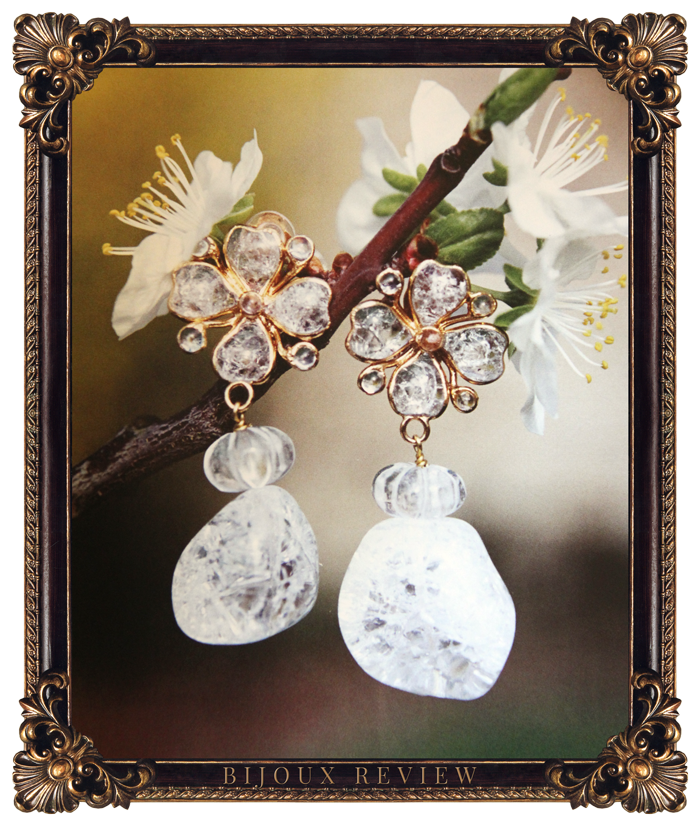
Vermeil and rock crystal flower earrings make an eternal springtime statement. Photo by Rose Deren from Loulou de la Falaise: The Glamorous Romantic (Rizzoli). Frame courtesy of EKDuncan.
After Yves Saint Laurent died in 2008. Betty Catroux relates how she and Loulou comforted each other as they grieved for him. Endlessly creative, Loulou (with the help of her business partner Ariel de Ravenel) threw herself into designing a line of fanciful jewelry and accessories for Home Shopping Network. (I used to tune into Loulou’s HSN television appearances for entertainment. Her chic clothes, dry wit and Anglo-French drawl made an amusing contrast to the spray-tanned, generically clad HSN segment hostesses who hyped Loulou’s products like carnival barkers.)
Now that she was working only part-time, Loulou’s garden at her Boury country house became even more of a consuming passion than before. When she became terminally ill, visits and lunches were hosted for friends such as Ariel de Ravenel, Betty Catroux and Pierre Bergé.
Loulou’s only child, art curator Anna Klossowski, turned twenty-six years old ten days before her mother passed away from liver cancer. As she relates in the book’s final chapter, “Maman said, ‘I have a present for you—it’s in the dresser.’ “I couldn’t find it, presumed ‘oh she’s forgotten’ and so I lied and said how lovely it was. But after she died, I found the package. Inside was a pair of beautiful Indian earrings.”
How appropriate that what must have been one of Loulou’s final encounters with exquisite jewelry involved selecting earrings for her beloved daughter.
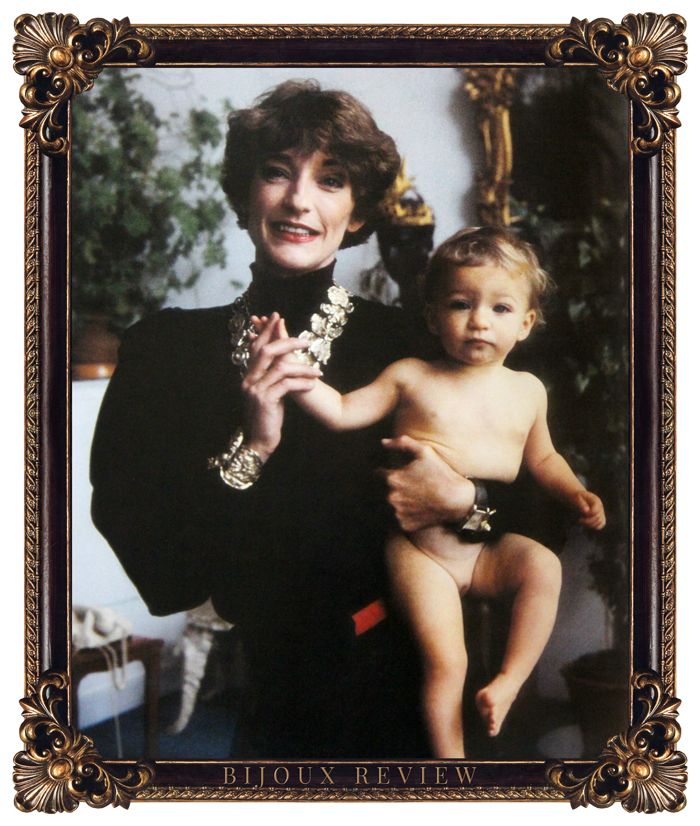
Loulou and her jewel of a one-year-old daughter Anna pose in the family’s rue des Plantes Paris apartment in 1986. Photo by Alice Springs for Harper’s & Queen, from Loulou de la Falaise: The Glamorous Romantic (Rizzoli). Frame courtesy of EKDuncan.
The book’s poignant presentation of Loulou’s jewels provides a graphic glimpse of great 20th century style and accessories (as well as the first decade of the 21st.) What imaginative marvels made manifest Loulou’s haute luxe jewels, back in the days before upmarket, uninspired jewelry made of inferior materials was globally branded as “luxury.”
The jewels that Loulou designed for YSL and for her eponymous line appealed as much to the jet set as they did to middle class women eager to cut loose from conventional fashion (and perhaps conventional female roles). Due to their strong scale, poetic design, vivid colors and Moroccan, African, Asian and nature-based motifs, these jewels stand the test of time…and they charm because they are so much more than mere enhancements for clothing.
Loulou’s jewels may also serve as charms, amulets or talismans that can protect the wearer from the impersonality that permeates everyday existence. Imaginative, exotic and hip, all of Loulou’s designs, variously made of horsehair, ebony inlaid with vermeil, crystals or jade magically look like souvenirs from voyages that many of us yearn to take…to unmapped lands.
The style of Loulou’s jewels (and hats and other accessories, for that matter) are characterized by a singularly colorful, poetic and romantically cross-cultural sense of earthy adventure. A wonderfully vibrant, often festive and immediately recognizable style animates Loulou’s bijoux. This stands as her lasting contribution to the narrative of late 20th and early 21st century jewelry history…and fashion. Long live Loulou!
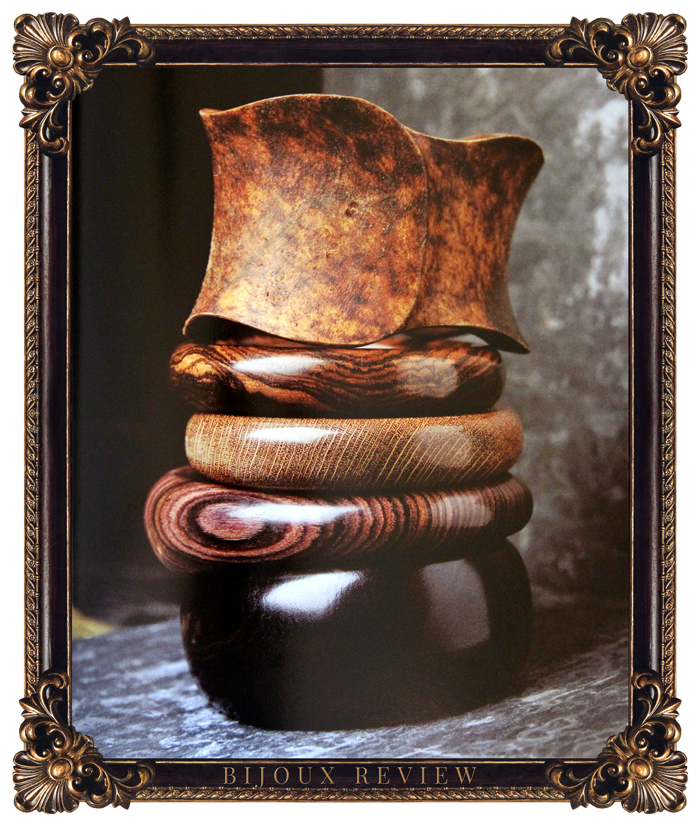
Loulou’s talent for designing organically beautiful jewels with pleasing texture and tactility extended to working with various woods, including ebony, which she used to great effect. Photo by Rose Deren, from Loulou de la Falaise: The Glamorous Romantic (Rizzoli). Frame courtesy of EKDuncan.
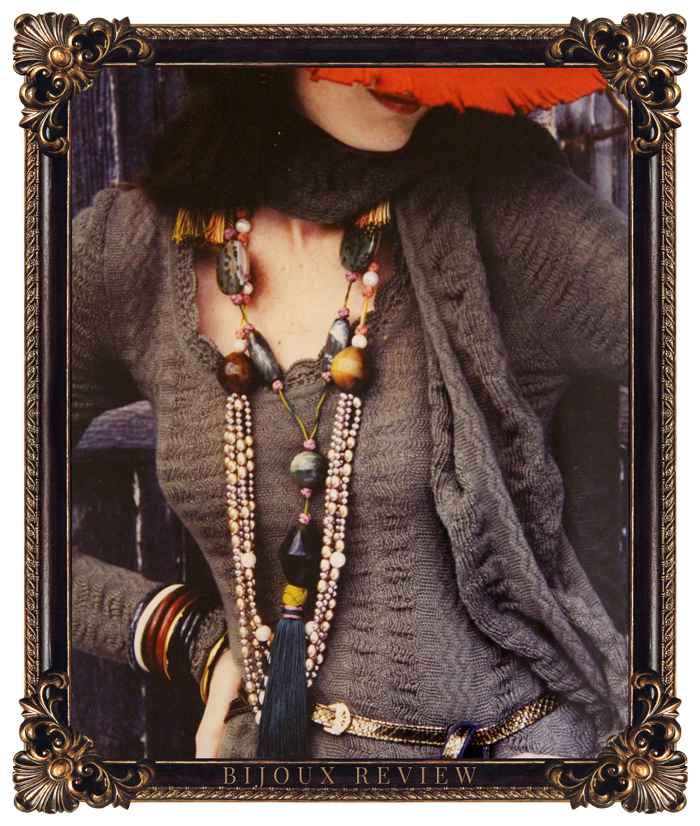
This romantic and figure-hugging sweater and scarf are balanced by organic-looking yet de luxe jewels, belt and bag…all designed by Loulou. Photo by Rose Deren, from Loulou de la Falaise: The Glamorous Romantic (Rizzoli). Frame courtesy of EKDuncan.
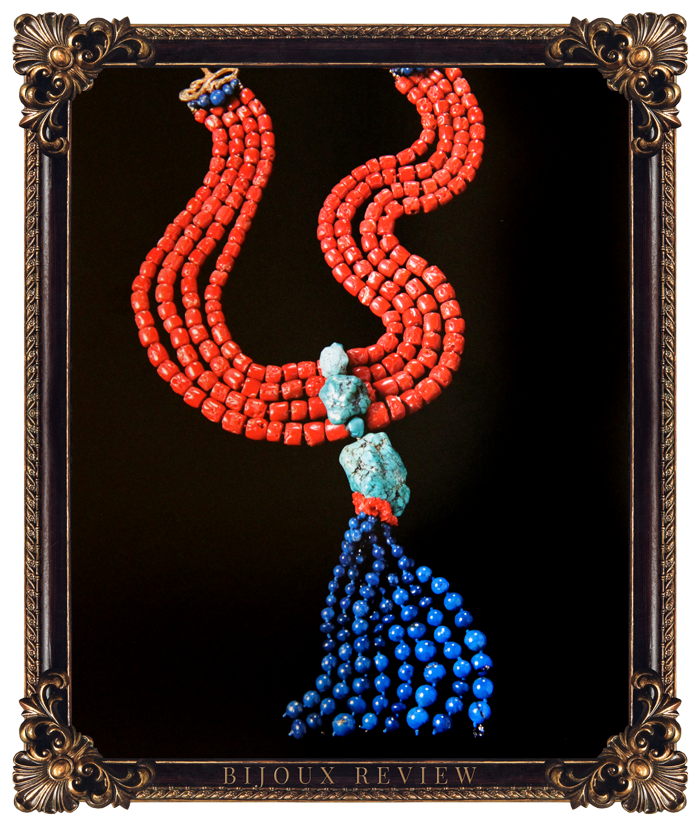
Loulou had a gift for taking semi-precious stones and turning them into precious jewelry designs with priceless allure. This coral and turquoise necklace with luxurious lapis tassel highlights Loulou’s dynamic color sense and love of kinetic jewels. Photo by Nicolas Matheus from Loulou de la Falaise: The Glamorous Romantic (Rizzoli). Frame courtesy of EKDuncan.
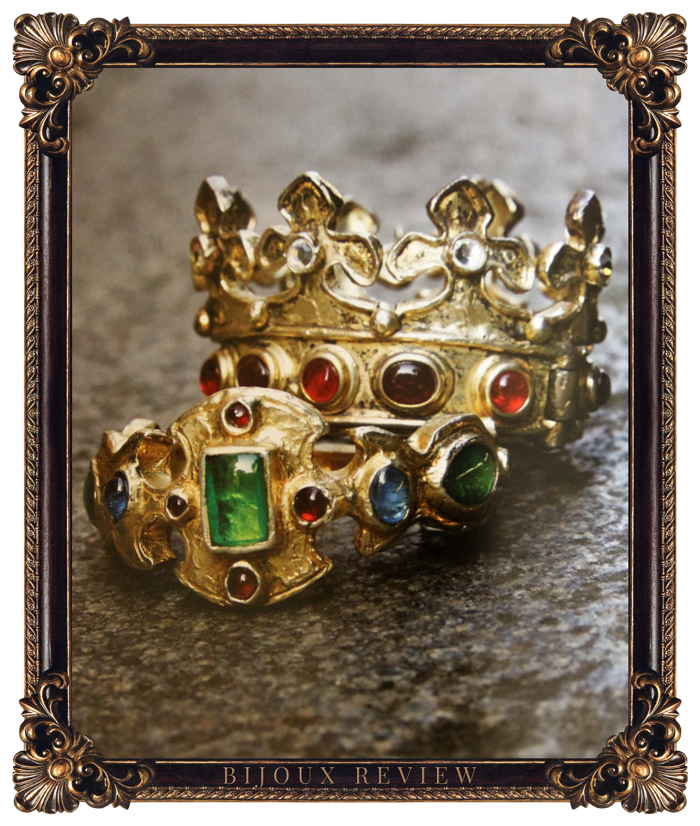
Regal poured glass cuff and bracelet from YSL’s 1978 Autumn-Winter haute couture collection. Photo by Rose Deren from Loulou de la Falaise: The Glamorous Romantic (Rizzoli). Frame courtesy of EKDuncan.
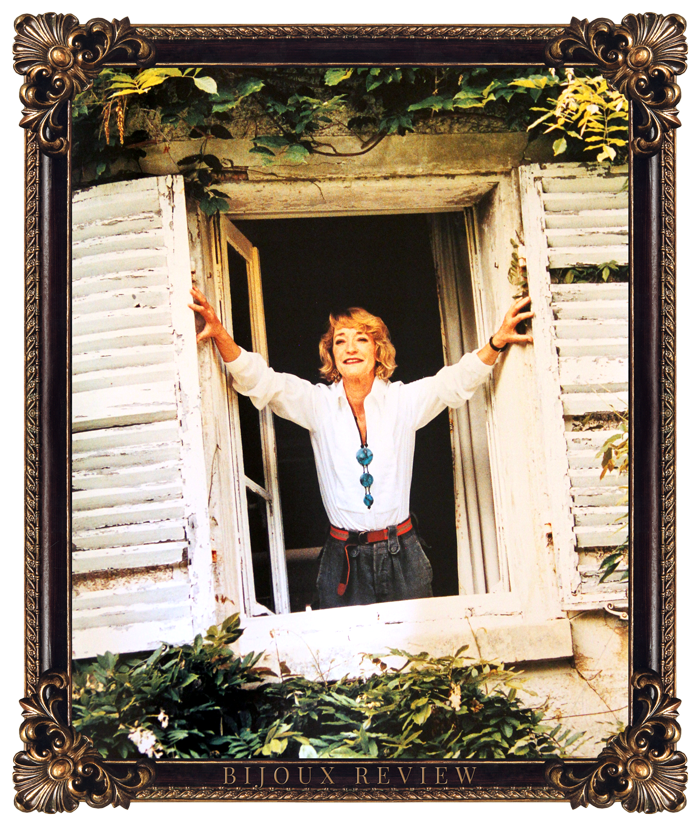
“Loulou was like the sun coming up in the morning,” relates John Fairchild, publisher and editor in chief of Women’s Wear Daily from 1960 to 1996 and the founding editor of W magazine. Here, Loulou lets the sun shine in at her country home in Boury, the Vexin, France. Uncredited photo from Loulou de la Falaise: The Glamorous Romantic (Rizzoli). Frame courtesy of EKDuncan.
Loulou de la Falaise: The Glamorous Romantic
by Ariel de Ravenel and Natasha Fraser-Cavassoni (Rizzoli)
Editor: Ariel de Ravenel
Writer: Natasha Fraser-Cavassoni
Art Director: Alexandre Wolkoff


Quite the authoritative survey on Loulou de la Falaise, her inimitable style, jewelry designs and the new book about her work. And I’d say that even if I were not your brother!
Everyone needs a little Loulou style in their life!
Style-wise, Loulou de la Falaise had it all going on. What an amusing and well-researched photo essay. Can’t wait to read the book that just came out about her.
Everyone who loves fashion should get Ariel de Ravenel’s and Natasha Fraser-Cavassoni’s amusing; authoritative book on Loulou de la Falaise.
Wonderful and detailed, authoritative insights about Lou Lou de F. Thank you.
LOULOU FOREVER!
Dear Kyle, this to thank you for the wonderful Loulou Forever review!
I am so thrilled you like the book, your heartfelt and very detailed account of its content is an amazing added tribute to the magic of Loulou.
I would love to be in touch if you would be so kind to forward your email.
Warm regards,
Ariel
Dear Ariel, your kind words about my article are enormously appreciated. You and Natasha Fraser-Cavassoni and Alexandre Wolkoff created such an excellent and colorful portrait of Loulou’s style and bijoux.